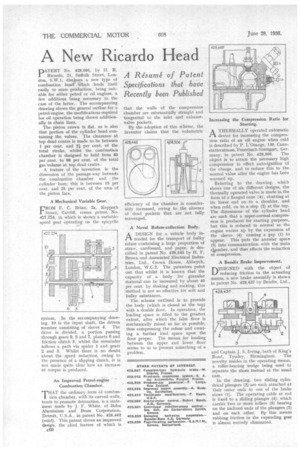A New Ricardo Head
Page 110

If you've noticed an error in this article please click here to report it so we can fix it.
A Résumé of Patent Specifications that have Recently been Published
DATENT No. 428,695, by II. R.
1 Ricardo, 21, Suffolk Street, London, S.W.1, discloses a new type of combustion head which lends itself easily to mass production, being suitable for either petrol or oil engines, a few additions being necessary in the case of the latter. The accompanying drawing shows the general outline for a petrol engine, the modifications required for oil operation being shown additionally in chain lines.
The piston crown is flat, as is also that portion of the cylinder head containing the valves, The clearance at top dead centre is made to be between I per cent. and 21 per cent, of the total stroke, whilst the combustion chamber is designed to hold from 85 per cent. to 98 per cent, of the total gas volume at top dead centre.
A feature of the invention is the dimension of the passage-way betwecon the combustion chamber and the cylinder bore; this is between 15 per cent. and 25 per cent, of the area of the piston face.
A Mechanical Variable Gear.
FROM F. C. Brian, 2a, Keppoch Street, Cardiff, comes patent No. 427,754, in which is shown a variablespeed gear operating on the epicyclic
system. In the accompanying dramMg, 10 is the input shaft, the driven member consisting of sleeve 4. The drive is divided, a portion passing through gears 9, 8 and 7, planets 6 and friction clutch 5, whilst the remainder follows a path via spider 1 and gears 2 and 3. Whilst there is no doubt about the speed reduction, owing to the presence of a slipping clutch, it is not made quite clear how an increase of torque is produced.
An Improved Petrol-engine Combustion Chamber.
T'THAT the ordinary form of combustion chamber, with its curved walls, tends to promote detonation, is a statement made by J. F. White, of Bohn Aluminium and Brass Corporation, Detroit, U.S.A., in patent No. 428,442 (void). This patent shows an improved design, the chief feature of which is
C60 that the walls of the compression chamber are substantially straight and tangential to the inlet and exhaustvalve pockets.
By the adoption of this scheme, the inventor claims that the volumetric efficiency of the chamber is considerably increased, owing to the absence of dead pockets that are not fully. scavenged.
A Novel Refuse-collection Body.
ADESIGN for a vehicle body intended for the transport of bulky refuse containing a large proportion of straw, cardboard, and paper, is described in patent No. 428,545 by H. F. Brown and Associated Electrical Industries, Ltd., Crown House, Aldwych, London, W.C.2. The patentees point out that whilst it is known that the capacity of a body for granular material can be increased by about 40 per cent. by shaking and rocking, this method is not so effective for soft and bulky substances.
The scheme outlined is to provide the body (which is closed at the top) with a double floor. In operation, the loading space is filled to the greatest extent, after which the false floor is mechanically raised so far as possible, thus compressing the refuse and creating a further load space upon the floor proper. The means for loading between the upper and lower floor seems to Us to present something of a problem. Increasing the Compression Ratio for Starting.
ATHERMALLY operated automatic device for increasing the compression ratio of an oil engine when cold is described by P. L'Orange, 130, Cannstatterstrasse, Feuerbach-Stuttgart, Ger
many, in patent No. 428,506. The object is to attain the necessary high compression to effect auto-ignition of the charge, and to reduce this to the normal value after the engine has been warmed up.
Referring to the drawing, which shows one of six different designs, the thermally operated valve is made in the form of a flanged cone (4), abutting at its lower end on to a shoulder, and when cold, on to a step (2) at the top. The dimensions of the cylinder head are such that a super-normal compression is produced for starting purposes, but this is reduced to normal as the engine warms up by the expansion of the sleeve (4) causing a gap (1) to appear. This puts the annular space (3) into communication with the main c ber, and thus effects the reduction of compression.
A Bendix Brake Improvement.
nESIGNED with the object of reducing friction in the actuating means, a new brake assembly is shown in patent No. 428,637 by Bendix, Ltd.,
and Captain J. S. Irving, both of King's Road, Tyseley, Birmingham. The novelty resides in the operating means, a roller-bearing wedge being used to separate the shoes instead of the usual cam.
In the drawing, two sliding cylindrical plungers (2) are each attached at their outer ends to one of the brake shoes (1). The operating cable or rod is fixed to a sliding plunger (4), which carries two or more rollers (3) bearing on the inclined ends of the plungers (2) and on each other, By this means rubbing friction in the expanding gear is almost entirely eliminated.




























































































































































